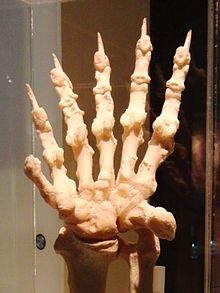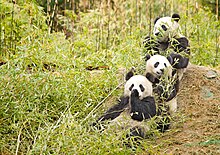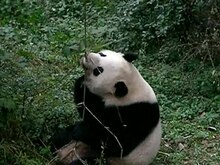Giant panda............

The giant panda (Ailuropoda melanoleuca, lit. "black and white cat-foot"; simplified Chinese: 大熊猫; traditional Chinese: 大熊貓; pinyin: dà xióng māo;Jyutping: daai6 hung4 maau1, lit. "big bear cat"),[2] also known as panda bear or simply panda, is a bear[3] native to south central China.[1] It is easily recognized by the large, distinctive black patches around its eyes, over the ears, and across its round body. The name "giant panda" is sometimes used to distinguish it from the unrelated red panda. Though it belongs to the order Carnivora, the giant panda's diet is over 99% bamboo.[4] Giant pandas in the wild will occasionally eat other grasses, wild tubers, or even meat in the form of birds, rodents or carrion. In captivity, they may receive honey, eggs, fish, yams,shrub leaves, oranges, or bananas along with specially prepared food.[5][6]
The giant panda lives in a few mountain ranges in central China, mainly in Sichuan province, but also in neighbouring provinces, namely Shaanxi andGansu.[7] As a result of farming, deforestation, and other development, the giant panda has been driven out of the lowland areas where it once lived.
The giant panda is a conservation reliant endangered species.[8] A 2007 report shows 239 pandas living in captivity inside China and another 27 outside the country.[9] As of December 2014, 49 giant pandas live in captivity outside China, living in 18 zoos in 13 different countries.[10] Wild population estimates vary; one estimate shows that there are about 1,590 individuals living in the wild,[9] while a 2006 study via DNA analysis estimated that this figure could be as high as 2,000 to 3,000.[11] Some reports also show that the number of giant pandas in the wild is on the rise.[12] In March 2015, Mongabay stated the wild giant panda population increased by 268, or 16.8%, totaling to 1,864 individuals.[13] However, the IUCN does not believe there is enough certainty yet to reclassify the species from endangered to vulnerable.[1]
While the dragon has often served as China's national symbol, internationally the giant panda appears at least as commonly. As such, it is becoming widely used within China in international contexts, for example as one of the five Fuwa mascots of the Beijing Olympics.
Description
The giant panda has luxuriant black-and-white fur. Adults measure around 1.2 to 1.9 m (4 to 6 ft) long, including a tail of about 10–15 cm (3.9–5.9 in), and 60 to 90 cm (2.0 to 3.0 ft) tall at the shoulder.[14][15] Males can weigh up to 160 kg (350 lb).[16] Females (generally 10–20% smaller than males)[17] can weigh as little as 70 kg (150 lb), but can also weigh up to 125 kg (276 lb).[8][14][18] Average adult weight is 100 to 115 kg (220 to 254 lb).[19]
The giant panda has a body shape typical of bears. It has black fur on its ears, eye patches, muzzle, legs, arms and shoulders. The rest of the animal's coat is white. Although scientists do not know why these unusual bears are black and white, speculation suggests that the bold coloring provides effective camouflage in their shade-dappled snowy and rocky habitat.[20] The giant panda's thick, wooly coat keeps it warm in the cool forests of its habitat.[20] The panda's skull shape is typical of durophagous carnivorans. It has evolved from previous ancestors to exhibit larger molars with increased complexity and expanded temporal fossa.[21][22]A 110.45 kg (243.5 lb) giant panda has a 3D canine teeth bite force of 2603.47 newtons and bite force quotient of 292.[citation needed] Another study had a 117.5 kg (259 lb) giant panda bit 1298.9 newtons (BFQ 151.4) at canine teeth and 1815.9 newtons (BFQ 141.8) at carnassial teeth.[23]
The giant panda's paw has a "thumb" and five fingers; the "thumb" – actually a modified sesamoid bone – helps it to hold bamboo while eating.[24] Stephen Jay Gould discusses this feature in his book of essays on evolution and biology, The Panda's Thumb.
The giant panda's tail, measuring 10 to 15 cm (4 to 6 in), is the second-longest in the bear family. (The longest belongs to the sloth bear.)[17]
The giant panda typically lives around 20 years in the wild and up to 30 years in captivity.[25] A female named Jia Jia is oldest giant panda ever in captivity and the oldest giant panda still living in captivity at an age of 37, as of July 2015.[26]
Behavior
The giant panda is a terrestrial animal and primarily spends its life roaming and feeding in the bamboo forests of the Qinling Mountains and in the hilly Sichuan Province.[27] Giant pandas are generally solitary,[28] and each adult has a defined territory, and a female is not tolerant of other females in her range. Social encounters occur primarily during the brief breeding season in which pandas in proximity to one another will gather.[29] After mating, the male leaves the female alone to raise the cub.[30]
Pandas were thought to fall into the crepuscular category, those who are active twice a day, at dawn and dusk, however, Jindong Zhang found that pandas may belong to a category all their own.[31]
Pandas communicate through vocalization and scent marking such as clawing trees or spraying urine.[8] They are able to climb and take shelter in hollow trees or rock crevices, but do not establish permanent dens. For this reason, pandas do not hibernate, which is similar to other subtropical mammals, and will instead move to elevations with warmer temperatures.[32] Pandas rely primarily onspatial memory rather than visual memory.[33]
Though the panda is often assumed to be docile, it has been known to attack humans, presumably out of irritation rather than aggression.[34][35][36]
Diet
Despite its taxonomic classification as a carnivoran, the giant panda's diet is primarily herbivorous, consisting almost exclusively of bamboo.[25] However, the giant panda still has the digestive system of a carnivore, as well as carnivore-specific genes,[37] and thus derives little energy and little protein from consumption of bamboo. Its ability to digest cellulose is ascribed to the microbes in its gut.[38][39] Pandas are born with sterile intestines, and require bacteria obtained from their mother's feces to digest vegetation.[40] The giant panda is a "highly specialized" animal with "unique adaptations", and has lived in bamboo forests for millions of years.[28] The average giant panda eats as much as 9 to 14 kg (20 to 30 lb) of bamboo shoots a day to compensate for its low level of energy digestibility. Ingestion of such a large quantity of material is possible due to the rapid passage of large amounts of indigestible plant material through the short, straight digestive tract.[41][42] It is also noted, however, that such rapid passage of digesta limits the potential of microbial digestion in the gastrointestinal tract,[41]limiting alternative forms of digestion. Given this large diet, the giant panda defecates up to 40 times a day.[43] The limited energy input imposed on it by its diet has affected the panda's behavior. The giant panda tends to limit its social interactions and avoids steeply sloping terrain to limit its energy expenditures.[44]
Two of the panda's most distinctive features, its large size and round face, are adaptations to its bamboo diet. Anthropologist Russell Ciochon observed: "[much] like the vegetarian gorilla, the low body surface area to body volume [of the giant panda] is indicative of a lower metabolic rate. This lower metabolic rate and a more sedentary lifestyle allows the giant panda to subsist on nutrient poor resources such as bamboo."[44] Similarly, the giant panda's round face is the result of powerful jaw muscles, which attach from the top of the head to the jaw.[44] Large molars crush and grind fibrous plant material.
The morphological characteristics of extinct relatives of the giant panda suggest that while the ancient giant panda was omnivorous 7 million years ago (mya), it only became herbivorous some 2-2.4 mya with the emergence of A. microta.[45][46] Genome sequencing of the giant panda suggests that the dietary switch could have initiated from the loss of the sole T1R1/T1R3 umami taste receptor, resulting from two frameshift mutations within the T1R1 exons.[47] Umami taste corresponds to high levels of glutamate as found in meat, and may have thus altered the food choice of the giant panda.[48] Although the pseudegenization of the umami taste receptor in Ailuropoda coincides with the dietary switch to herbivory, it is likely a result of, and not the reason for, the dietary change.[46][47][48]The mutation time for the T1R1 gene in the giant panda is estimated to 4.2 mya[46] while fossil evidence indicates bamboo consumption in the giant panda species at least 7 mya,[45] signifying that although complete herbivory occurred around 2 mya, the dietary switch was initiated prior to T1R1 loss-of-function.
Pandas eat any of 25 bamboo species in the wild, such as Fargesia dracocephala[49] and Fargesia rufa.[50] Only a few bamboo species are widespread at the high altitudes pandas now inhabit. Bamboo leaves contain the highest protein levels; stems have less.[51]
Because of the synchronous flowering, death, and regeneration of all bamboo within a species, the giant panda must have at least two different species available in its range to avoid starvation. While primarily herbivorous, the giant panda still retains decidedly ursine teeth, and will eat meat, fish, and eggs when available. In captivity, zoos typically maintain the giant panda's bamboo diet, though some will provide specially formulated biscuits or other dietary supplements.[52]
Pandas will travel between different habitats if they need to, so they can get the nutrients that they need and to balance their diet for reproduction. For six years, scientists studied six pandas tagged with GPS collars at the Foping Reserve in the Qinling Mountains. They took note of their foraging and mating habits, and analysed samples of their food and feces. The pandas would move from the valleys in to the Qinling Mountains and would only return to the valleys in autumn. During the summer months bamboo shoots rich in protein are only available at higher altitudes which causes low calcium rates in the pandas and during breeding season the pandas would trek back down to eat bamboo leaves rich in calcium.



No comments:
Post a Comment